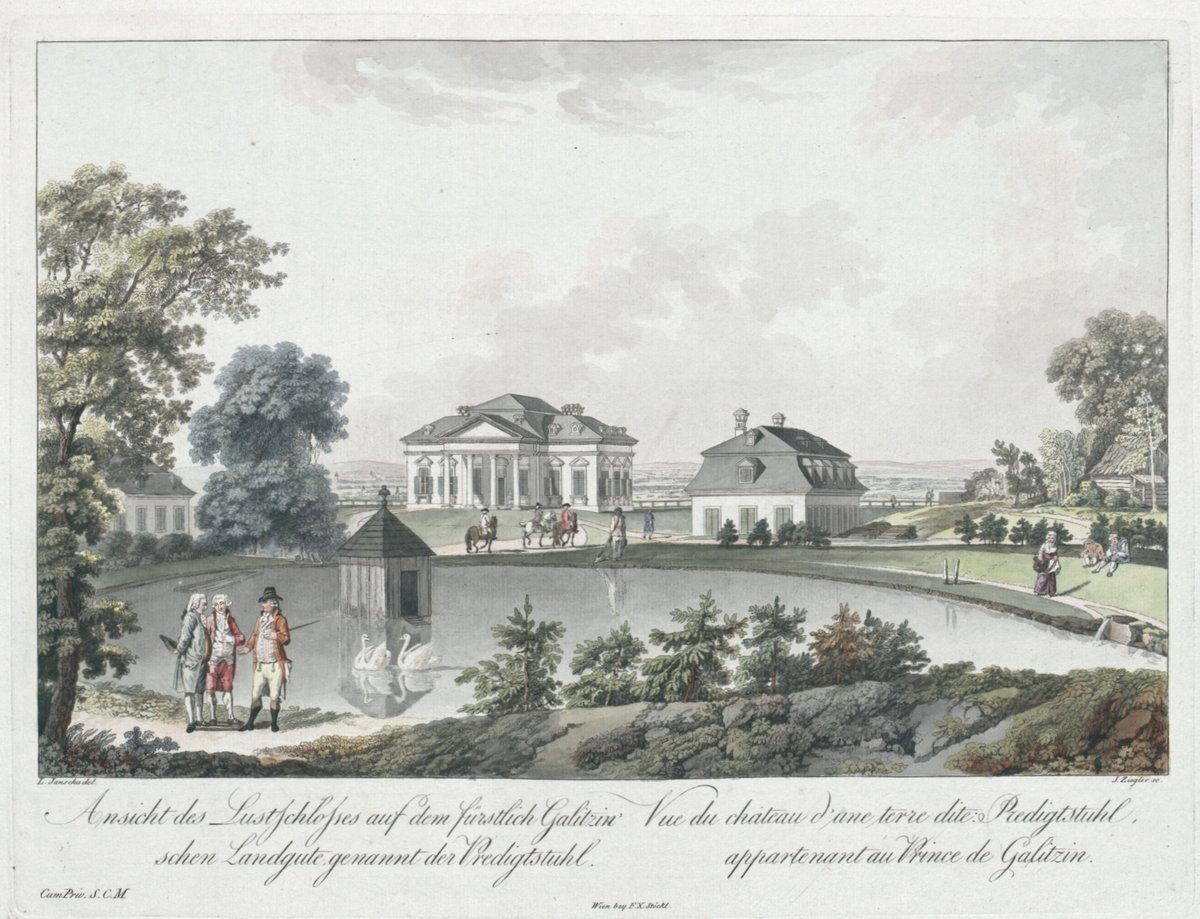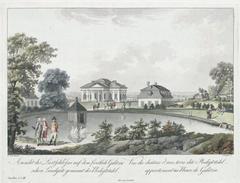
Schloss Wilhelminenberg Vienna: Visiting Hours, Tickets, and Complete Travel Guide
Date: 15/06/2025
Introduction
Perched atop Vienna’s scenic Wilhelminenberg hill in the 16th district, Schloss Wilhelminenberg is an emblem of Austria’s aristocratic past and architectural grandeur. Built in the late 18th century, this historic palace has transitioned from a noble residence to a philanthropic hub, wartime hospital, children’s home, and, today, a distinguished four-star hotel. Set amid lush parklands, the palace offers sweeping views of Vienna and the Vienna Woods, blending historical intrigue with serene natural beauty (Planet Vienna; Wikipedia; Austria Trend). This guide details everything you need to plan your visit, from opening hours and ticketing to historical highlights, accessibility, and local travel tips.
Historical Overview
18th-Century Foundations
The origins of Schloss Wilhelminenberg date to 1781 when Field Marshal Count Franz Moritz von Lacy acquired the “Predigtstuhl” property, envisioning a leisure palace. Within a few years, Russian ambassador Prince Dmitri Mikhailovich Galitzin expanded the estate, adding landscaped gardens, temples, and a hunting lodge. The public affectionately named the hill “Gallitzinberg” in his honor (Planet Vienna). After Galitzin’s death in 1793, the estate changed hands several times, each owner leaving their mark (Tour My Country).
19th-Century Expansion and the Montléart Legacy
In 1824, French Prince Julius de Montléart and Princess Maria Christina of Saxony acquired the estate, expanding it in 1838 with neo-Classical side wings (Wikipedia). Their son, Prince Moritz de Montléart, named the palace and hill after his wife, Wilhelmine, a noted philanthropist. Wilhelmine’s charity work left a lasting legacy, and both she and Moritz are interred in a mausoleum near the palace (Planet Vienna).
Habsburg Era and 20th-Century Transformations
By the early 1900s, the palace had deteriorated. Wilhelmine’s grandson, Archduke Rainer of Habsburg-Lothringen, commissioned a new residence in the neo-Empire style, completed in 1908 (Wikipedia). The Habsburg family resided here until the monarchy’s end in 1918, after which the estate transitioned to new roles. It briefly housed the Vienna Boys’ Choir before being seized by the Nazis during World War II, serving as a hospital and command center.
Postwar, Schloss Wilhelminenberg became a children’s home and facility for social welfare, later operating as a special education institution until the late 1970s (Planet Vienna). The palace’s past as a children’s home included a troubled chapter, with reports of abuse emerging in recent years and prompting official investigations (Ganz Wien).
Renovation and Modern Use
A significant renovation in the late 1980s restored the palace, and in 1988 it reopened as a hotel (Wikipedia). Further upgrades in 2000 transformed it into the Austria Trend Hotel Schloss Wilhelminenberg, featuring 87 rooms, a restaurant, library, and extensive conference facilities within a 120,000 m² park (Austria Trend).
Architectural and Natural Highlights
The current palace, finished in 1908, showcases neo-Empire symmetry, a grand entrance, and elegant interiors. Surrounded by meadows, woods, and vineyards, it provides a tranquil escape and panoramic city views (Wien Info). The interior features high ceilings, ornate detailing, and historic public rooms, while modern amenities ensure guest comfort.
The adjacent parkland, open to the public, invites leisurely strolls, picnics, and photography. The hilltop location is especially prized for sunset vistas and city panoramas.
Visiting Schloss Wilhelminenberg
Opening Hours
- Park and Grounds: Open daily from 7:00 AM to 9:00 PM (Booking.com).
- Public Areas (Café, Restaurant, Winter Garden): Open during business hours; check the hotel website for specifics.
- Guided Tours and Events: Offered occasionally, often by appointment or during special events. Advance booking recommended.
Admission and Tickets
- Grounds and Park: Free entry.
- Guided Tours/Special Events: Tickets required; purchase online or at the hotel.
- Interiors: Access is primarily for hotel guests and event participants, though the café and restaurant are open to all.
Accessibility and Facilities
- Wheelchair Access: Ramps and adapted restrooms available in public areas.
- Café and Dining: Non-residents welcome; reservations advised during peak times.
- Pet Policy: Pets allowed in the hotel (charges may apply); confirm when booking.
- Parking: Free on-site parking for guests and visitors—a rarity in Vienna.
- Wi-Fi: Complimentary throughout the property.
Getting There
- By Public Transport: Bus lines 46A and 46B stop directly in front of the palace, connecting to central Vienna in about 25 minutes (Booking.com).
- By Car: Ample on-site parking.
- Cycling: The estate is reachable via local bike routes.
- Nearby Tram/U-Bahn: Additional connections via Vienna’s efficient transit network.
Dining and Accommodation
- Hotel: 87 elegant rooms with modern amenities, including free Wi-Fi, safes, and desks (Booking.com).
- Winter Garden: Breakfast buffet with continental, vegetarian, and Viennese options.
- Restaurant: Focuses on traditional Viennese cuisine, with indoor and terrace seating.
- Schloss Café: Offers pastries and coffee, perfect for a midday break with a view.
Events, Weddings, and Special Occasions
Schloss Wilhelminenberg is a popular venue for weddings, conferences, and private celebrations, offering tailored packages and professional event coordination. Advance booking is essential, especially during peak wedding season.
Nearby Attractions
- Vienna Woods: Ideal for hiking and nature walks.
- Schloss Neuwaldegg: Another historic estate nearby.
- Ottakring District: Home to the Ottakringer Brewery and the lively Brunnenmarkt.
- Kuffner Observatory: For astronomy enthusiasts.
- Wallfahrtskirche zur Heiligen Theresia: A notable local church.
Frequently Asked Questions (FAQ)
Q: What are the visiting hours?
A: Park and grounds: 7:00 AM–9:00 PM; café and restaurant hours vary.
Q: Is there an entrance fee?
A: Grounds and park: free; guided tours/events: ticket required.
Q: Are guided tours available?
A: Occasionally, by booking or during special events.
Q: Are pets allowed?
A: Yes, in hotel rooms (charges may apply); confirm policy when booking.
Q: Is the castle wheelchair accessible?
A: Yes, public areas are accessible; check in advance for specific needs.
Q: How do I get there by public transport?
A: Use bus lines 46A or 46B from central Vienna. Tram and U-Bahn connections are also nearby.
Seasonal and Practical Tips
- Best Times to Visit: Spring and summer for gardens and terraces; autumn for colorful foliage; winter for a fairytale castle ambiance.
- Photography: Bring your camera for city and sunset views.
- Reservations: Essential for hotel stays and dinner, especially on weekends and holidays.
- Events: Check for weddings or private functions that may limit access to certain areas.
- Special Offers: Look for seasonal promotions or Genius discounts online.
Historical and Cultural Context
Schloss Wilhelminenberg’s layered history reflects Vienna’s transformation from imperial grandeur through 20th-century upheavals to modern cultural renewal. The estate’s past as a children’s home includes a difficult legacy of abuse, acknowledged through official investigations and ongoing discussions about institutional accountability (Ganz Wien). Today, the palace stands as a testament to Vienna’s resilience, harmonizing historic preservation with contemporary hospitality and community engagement (Tour My Country; Austria Trend).
Visuals and Media
For immersive planning, explore the official Austria Trend Hotel Schloss Wilhelminenberg website for virtual tours, high-resolution images, and maps. Photos of the palace, grounds, interiors, and panoramic views are available, enhancing your visitor experience.
Booking and Visitor Recommendations
- Book Early: Especially for weekends, holidays, or special events.
- Dining: Reserve your table, particularly for the terrace in summer.
- Accommodation: Choose from a range of room types, all with modern comforts in a historical setting.
- Explore the District: Ottakring offers vibrant markets, taverns, and local attractions.
- Plan Your Transport: Utilize Vienna’s efficient public transport or take advantage of free on-site parking.
Conclusion
Schloss Wilhelminenberg invites visitors to experience Vienna’s aristocratic charm, historical depth, and breathtaking natural surroundings. Whether for a leisurely day trip, a romantic overnight stay, or a special event, the estate offers a harmonious blend of past and present. Download the Audiala app for interactive guides, exclusive content, and up-to-date visitor information. Share your visit with #SchlossWilhelminenbergVisit!
Internal and External Links
-
[Vienna Historical Sites Guide]
-
[Top Hotels in Vienna]
-
[Travel Tips for Vienna Visitors]
Sources and Further Reading
- Visiting Schloss Wilhelminenberg: History, Tickets, and Travel Tips for Vienna’s Historic Palace, 2025, Planet Vienna (https://planet-vienna.com/schloss-wilhelminenberg/)
- Schloss Wilhelminenberg, 2025, Wikipedia (https://en.wikipedia.org/wiki/Schloss_Wilhelminenberg)
- Austria Trend Hotel Schloss Wilhelminenberg, 2025, Austria Trend (https://www.austria-trend.at/en/hotels/schloss-wilhelminenberg)
- Visiting Schloss Wilhelminenberg: Hours, Tickets, and Historical Insights on Vienna’s Aristocratic Estate, 2025, Official Vienna Tourism (https://www.wien.info/en/livable-vienna/walks-in-vienna/wilhelminenberg-365968)
- Schloss Wilhelminenberg Visiting Hours, Tickets, and Visitor Guide, 2025, Booking.com (https://www.booking.com/hotel/at/schloss.html)
- Visiting Schloss Wilhelminenberg: History, Tickets, Visiting Hours, and Controversies, 2025, Ganz Wien (https://www.ganz-wien.at/wien/sehenswuerdigkeiten/schloss-wilhelminenberg.html)
- Tour My Country - Schloss Wilhelminenberg Vienna, 2025 (http://www.tourmycountry.com/austria/wilhelminenberg-vienna.htm)






















































































































































